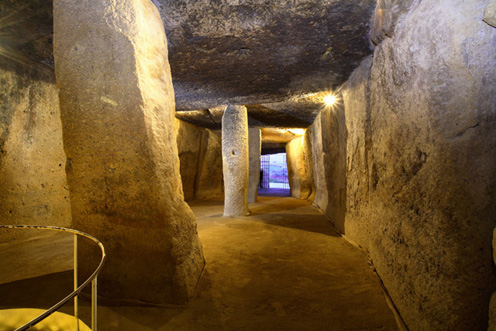Spain is the third country in the world with the most assets included on the World Heritage List: the Antequera Dolmens Site is the 45th cultural asset in Spain to be added to this prestigious list. Furthermore, Spain has 14 assets on the Intangible Heritage List and five Documentary Heritage entries in the Memory of the World Register.
Íñigo Méndez de Vigo, the Spanish Minister for Education, Culture and Sport, expressed his pride over the declaration and thanked the Regional Government of Andalusia, the City Council of Antequera, the Antequera Dolmens Archaeology Centre and the scientific community, as well as UNESCO and ICOMOS (the consultation body of the World Heritage Convention), for the ongoing and arduous work to include this asset on the List of World Heritage Sites. "But the work does not end here, because this declaration brings with it a series of commitments. The inclusion of an asset on this list is not the ultimate goal but rather just the beginning for better conservation. The World Heritage cultural asset managers and the competent authorities need to keep working on the management, supervision, preservation and promotion of the asset".
Iñigo Méndez de Vigo visited the Antequera Dolmens Site archaeology centre on 14 December. During his visit, the minister said that, "upon entering this site today, I felt as if life is lived from the past and understood through the past. It is truly exciting to see here, right where we are standing now, that people were already living on these lands millions of years ago and practising funeral rites". Furthermore, he stressed that "the value of the Antequera Dolmens should be recognised here; I believe this is an expression of the cultural heritage of Andalusia".
The inclusion of both natural and cultural assets in other countries was also recommended at this 40th Session of the World Heritage Committee, which was attended by a delegation from the Ministry for Education, Culture and Sport, led by the Deputy Director-General for Historical Heritage Protection, Elisa de Cabo. These assets include: the Architectural Work of Le Corbusier (a bid involving Argentina, Belgium, France, Germany, India, Japan and Switzerland); the Revillagigedo Archipelago in Mexico; Mistaken Point in Canada; and the Khangchendzonga National Park in India, among others.
Inclusion criteria
The UNESCO World Heritage Committee has followed the recommendation of its consultation body - ICOMOS (International Council on Monuments and Sites) - which stated in its report that the Antequera Dolmens Site possesses Exceptional Universal Value.
The Antequera Dolmens Site comprises a series of three megalithic monuments: the Menga Dolmen, the Viera Dolmen and the Tholos of El Romeral, as well as two natural monuments: the Peña de los Enamorados and El Torcal de Antequera. Built during the Neolithic Period and the Bronze Age using large stone blocks to form the rooms and spaces covered with lintels (Menga and Viera) or a false dome (El Romeral), they were used for ritual and funeral purposes. The Antequera megaliths are an exceptional example of megalithic art in Europe. The megalithic structures resemble a natural landscape (buried under mounds of earth) and their orientation is focused on two natural monuments: the Peña de los Enamorados and El Torcal, two clearly visible points of reference.
Interaction between the megalithic monuments and nature can be seen in the deep wells located inside Menga and in the orientation of Menga and El Romeral towards the sacred mountains (La Peña de los Enamorados and El Torcal), accentuating the unique nature of this prehistoric funeral and ritual landscape. Given the unique nature of their design and their technical differences and formal solutions, the three tombs represent the major traditions of megalithic funeral architecture on the Iberian Peninsula.
The Antequera Dolmens Site consists of three megalithic monuments: the Menga Dolmen, the Viera Dolmen and the Tholos of El Romeral, as well as two natural monuments: the Peña de los Enamorados and El Torcal. It is one of the oldest and most original forms of landscape monumentalisation through the integration of megalithic architecture and nature that we know of from the Prehistoric world, a major ritual centre whose origin dates back to the first half of the fourth millennium before Christ.
Megalithic art connects societies from very different times and spaces, and has been developed worldwide over the last 100,000 years under very different conditions and circumstances, meaning that this phenomenon is of global significance.
During prehistoric times, Antequera was a natural crossroads of routes between seas and continents, and a meeting point for different peoples and cultures. This gave rise to the emergence of outstanding architectural models and a culture based on exceptional interaction with the landscape, in which the megalithic constructions (the Menga Dolmen, the Viera Dolmen and the Tholos of El Romeral) were built to resemble a natural landscape (the megalithic monuments are buried beneath mounds of earth), with their orientation focused on two natural phenomena: La Peña de los Enamorados and El Torcal, which represent the undeniable visual benchmarks at the site.
The physical and conceptual relationship with the natural environment is a common aspect of megalithic phenomena. However, what makes the Antequera Site genuinely original is the close and intimate dialogue established between the megalithic architecture and nature; an aspect that gives this site unique relevance on a universal scale and has no parallel on the World Heritage List or in other recognised assets of a similar nature.





